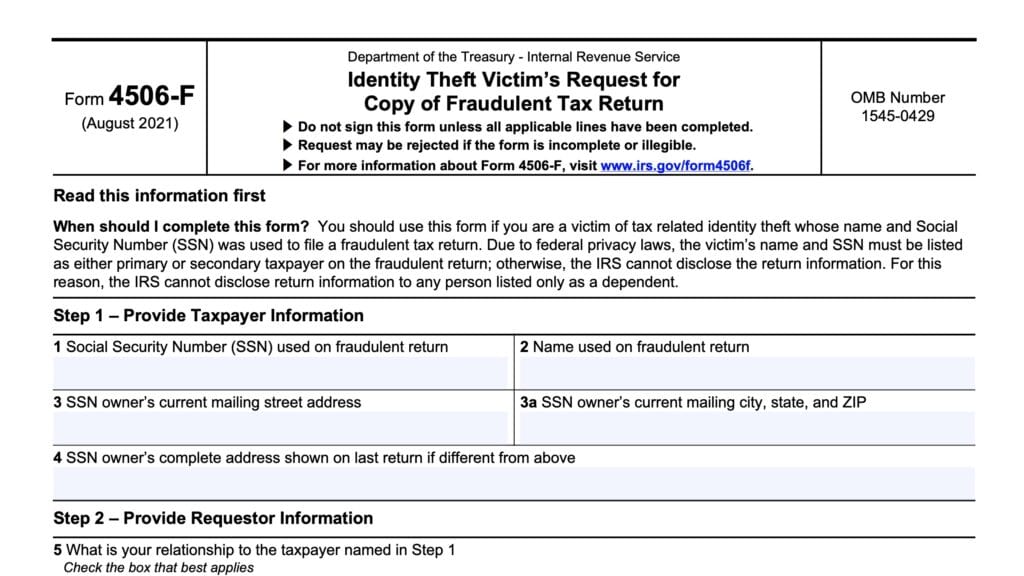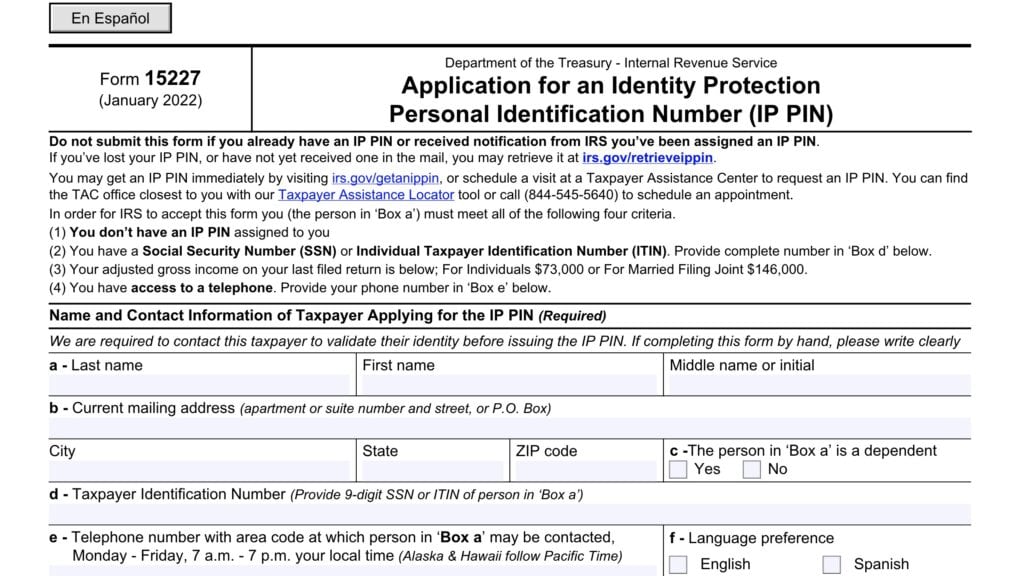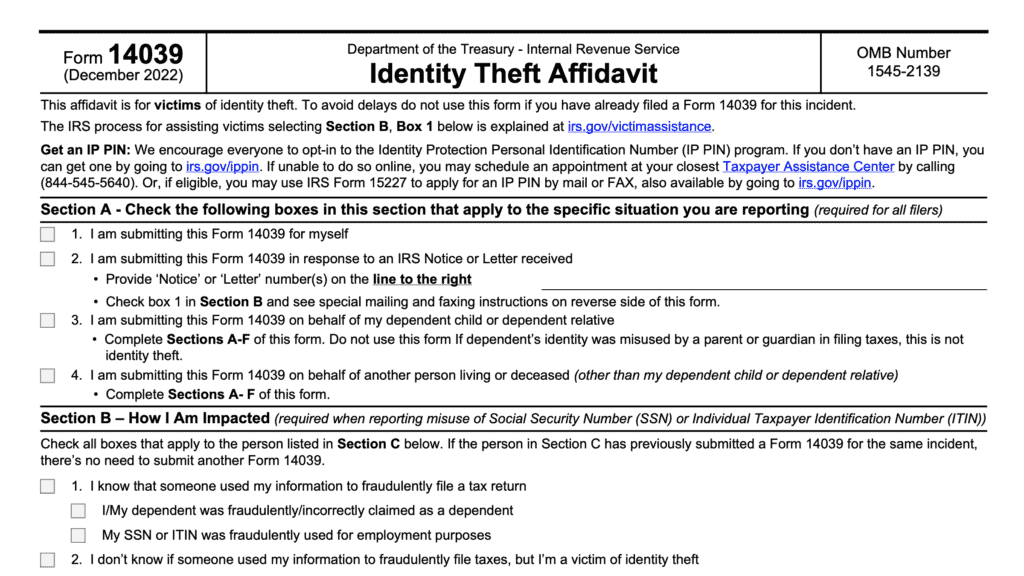IRS Form 15103 Instructions
If you’ve recently received a CP59 notice, the IRS may be asking you why you did not file your tax return. Included in your notice should be a copy of IRS Form 15103, Form 1040 Return Discrepancy.
In this article, we’ll walk through everything you should know about IRS Form 15103, including:
- How to complete and file IRS Form 15103
- What you should do if you receive a CP59 notice
- Tax penalties that may apply to missing returns
- Reasons you might want to file IRS Form 15103, even if you don’t owe taxes
Let’s dive into the tax form itself.
Table of contents
How do I complete IRS Form 15103?
If you’re completing the form that was sent to you in IRS Notice CP 59, then you should be aware that this form has two sides that you must complete.
If you receive IRS Notice CP59
After receiving this tax notice, you should make sure you understand it before diving into your Form 15103. Watch this video to learn more.
Let’s go through how to complete Form 15103, beginning with the taxpayer information at the top of the form.
Taxpayer information
At the top of IRS Form 15103, you’ll enter your contact information, in case the IRS has additional requests.
Social Security number
In this field, enter your Social Security number as it would appear on your own tax return or in your IRS notice.
If you don’t have a Social Security number
If you don’t have a Social Security number, you should enter your individual taxpayer identification number (ITIN) as it would have appeared on your tax return. For individuals who have neither a Social Security number or an ITIN, you can apply for an ITIN by filing IRS Form W-7, Application for IRS Individual Taxpayer Identification Number.
Taxpayer name
Enter your name as it appeared in your IRS letter.
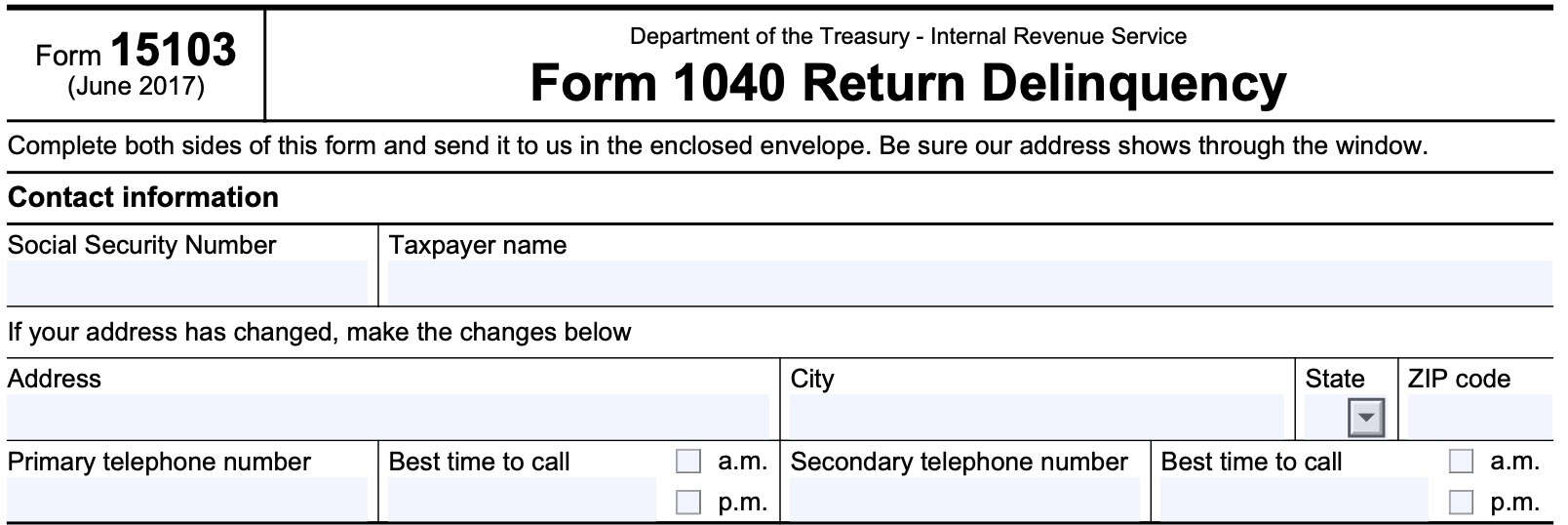
Address and Phone number
Enter your address, if it has changed since your most recent prior personal tax return, or if you know that it is different from your income transcripts. Include the following information:
- Street name and number
- City, state, zip code
- Primary telephone number & best time to call
- You may list a second phone number if you wish
Once you’ve entered your personal information, we’ll go to the next section, where you’ll give the IRS a little more information about your missing return.
Circumstances that may apply to you
In this section, you can inform the Internal Revenue Service whether:
- You already filed your income tax return, or
- If the addressee on this IRS notice is deceased
Let’s take a closer look at each situation.
If you already filed a tax return
If you filed your tax return for this particular year, then you should do the following:
- Check the box indicating that you’ve filed the missing return and enter the tax year
- Complete the remaining fields with the following information:
- Taxpayer name(s) as shown on the return
- Tax forms filed, such as IRS Form 1040
- Tax return year (or years)
- Tax return date field (or dates filed)
Additionally, you’ll need to enclose a signed copy of the return with your completed Form 15103 when you send it to the IRS.
Let’s take a closer look at how to complete this section if the addressee is a deceased taxpayer.
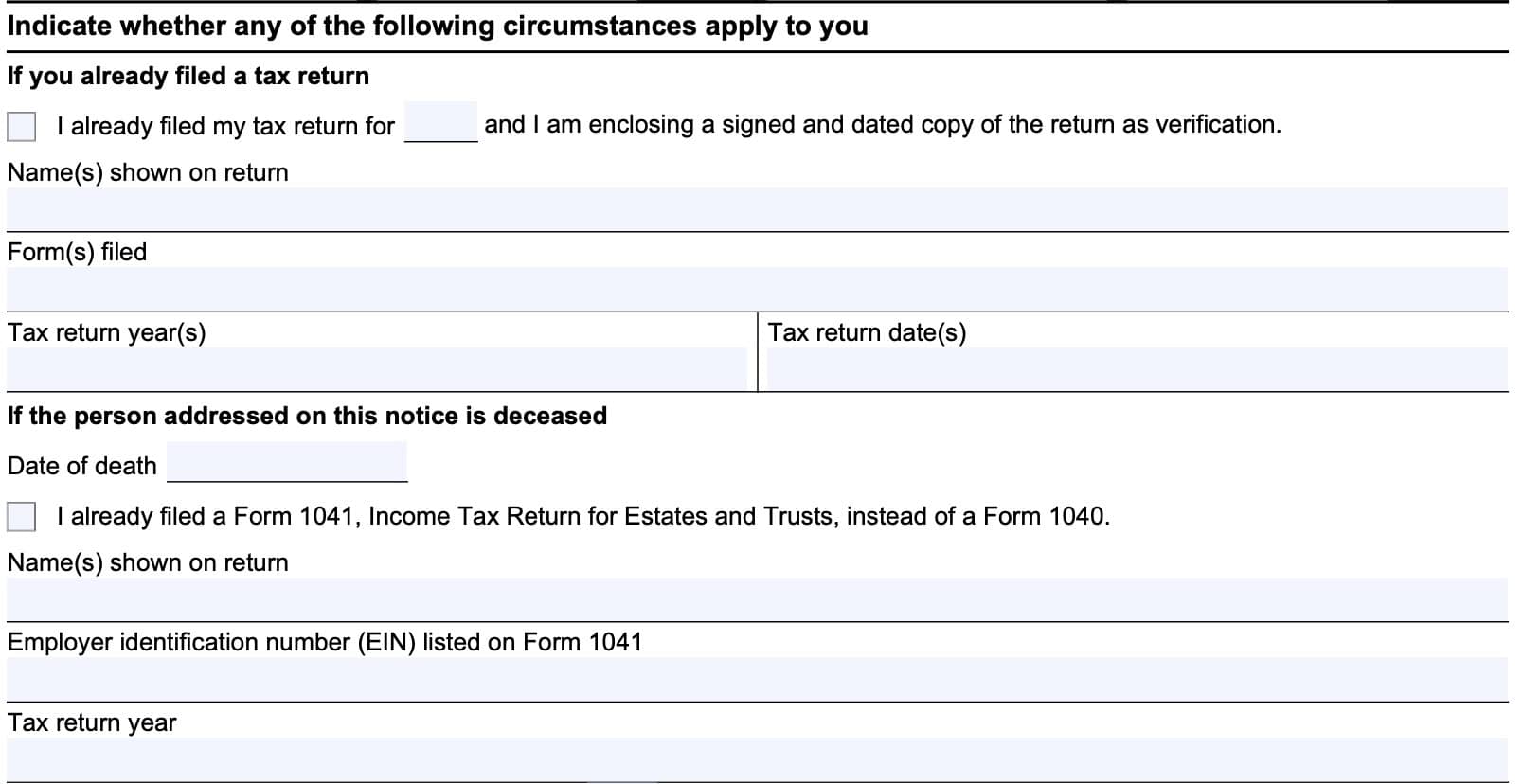
If the person addressed on this IRS notice is deceased
In this section, you should do the following:
- Enter the date of death in the space provided
- Check the box if you completed Form 1041, Income Tax Return for Estates and Trusts, instead of an individual tax return
- If applicable, enter the following information:
- The name (or names) as shown on the filed tax return
- Employer identification number as listed on the filed Form 1041
- Tax return year
Let’s go to the next section.
Why you don’t think you need to file a tax return
If you don’t believe that you’re responsible for one or more unfiled returns, then you’ll need to complete this section to provide your justification.
Tax year
Enter the tax year in question, in the three blanks at the top of this section:
- If you don’t think you have to file a tax return for ____
- Explain why you don’t think you are required to tax return for ____
- The answers to these questions apply to the ____ tax year only
Pro tip: If you received a notice concerning past due tax returns for multiple tax years, you may need to complete a separate Form 15103 for each applicable tax year. This form does not come with instructions, but this section indicates that you can only include tax information for unfiled return on each form.
Filing status
Enter your household’s filing status for the tax year in question. Here are your choices:
- Head of household
- Single
- Married filing jointly
- Qualified widow(er) with dependent child
- Married filing separately
If you’re not certain which taxfiling status applies to you, the IRS contains an online tool that will help you determine which filing status you are eligible to use.
Applicable conditions
In addition to your filing status, you may check one or more applicable boxes to help the IRS determine whether you had reasonable cause for your unfiled returns. Select any following conditions that apply to your tax situation:
- You or your spouse were age 65 or older during the tax year in question
- You or your spouse are legally blind
- You are not a U.S. citizen or permanent resident
- Your work was performed in another country
- Someone else can claim you as a dependent on his or her own tax return
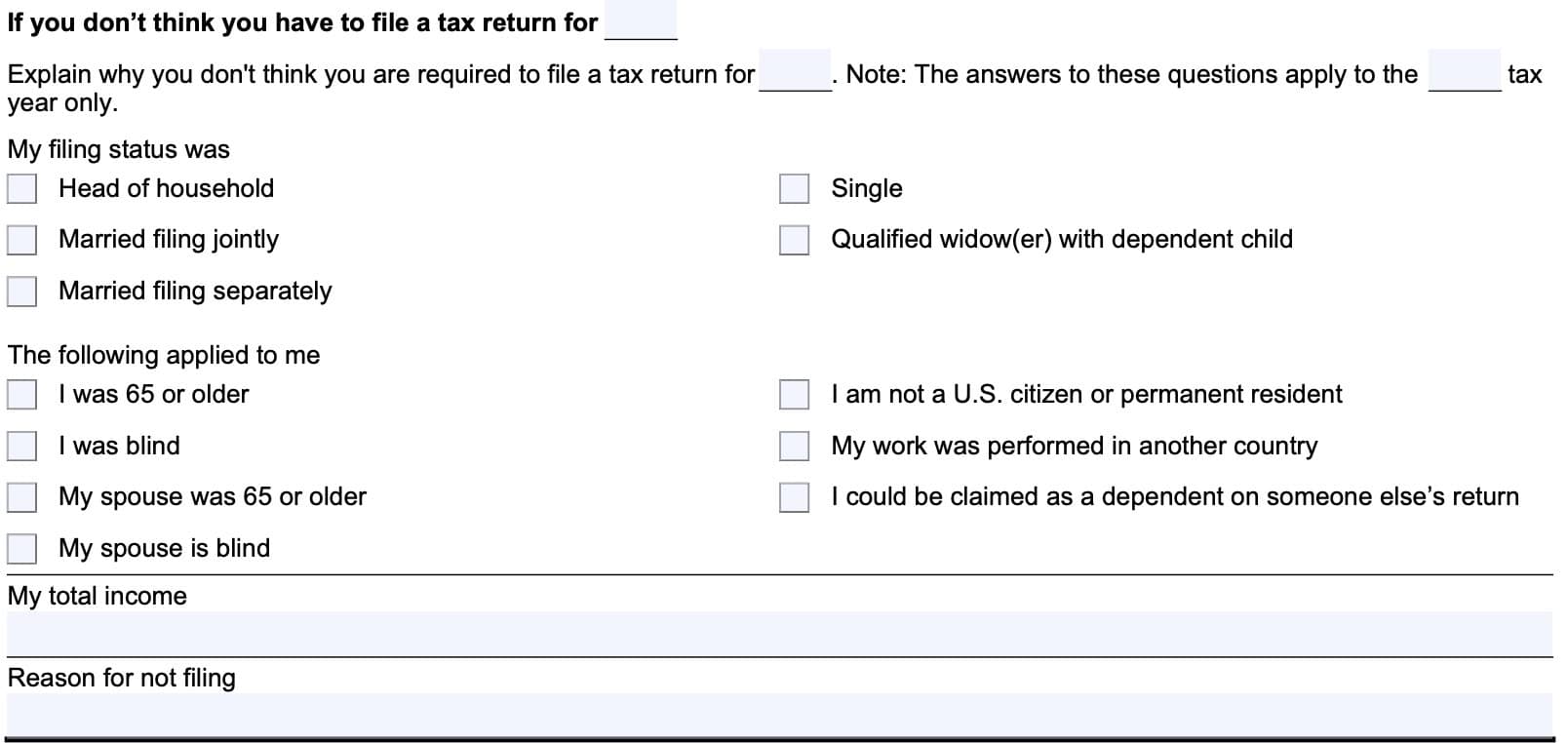
Total income
Enter your total income for the given tax year here. You should report all items of taxable income, especially income that has already been reported to the IRS.
Below are examples of income documents that contain tax information already reported to the Internal Revenue Service:
- IRS Form W-2, Wage and Tax Statement
- IRS Form 1099-MISC, Miscellaneous Income
- IRS Form 1099-NEC, Nonemployee Compensation
Reason for not filing
In this section, explain your reason for not filing your income tax return, or for your late filing, if applicable. Generally, the IRS will allow taxpayers to not file a timely tax return if:
- Your income is below the required filing threshold for that tax year, as indicated in IRS Publication 501 for that tax year
- Self-employed individuals with net self-employment income of $400 or more must file an annual return regardless of their total earnings amount
- Someone else can claim you as a dependent on his or her tax return
- Must be a parent or guardian
- You may still need to file your own return, depending on your income amount
- You can establish reasonable cause for not filing a tax return on time
- The IRS website lists the following as examples of reasonable cause:
- Fires, natural disasters or civil disturbances
- Inability to get records
- Death, serious illness or unavoidable absence of the taxpayer or immediate family
- System issues that delayed a timely electronic filing or payment
- Reasonable cause covers late filings, but does not cover unfiled tax returns or eliminate the filing requirement
- The IRS website lists the following as examples of reasonable cause:
If you do not meet one of these criteria, then you might be liable for unpaid taxes, interest charges and additional penalties, including:
- Failure-to-file penalty: Not filing a tax return by the due date may result in a monthly penalty of 5% of the unpaid tax balance (up to a limit of 25% of the total tax bill).
- Failure-to-pay penalty: You may owe a monthly penalty of 0.5% of the unpaid balance (up to a limit of 25% of the total tax balance)
Situations that do not justify not filing your tax return on time
While there are certain situations that the IRS will allow for a late return, other situations do not.
According to the IRS website, below are examples of tax issues that do not warrant a late filing or any tax return delinquency:
Reliance on a tax professional
You’re generally responsible for complying with tax law even if someone else handles your taxes. You should know what your tax preparer files and get proof that your return or payment is sent on time.
Pro tip: If your tax professional made a mistake that resulted in an unfiled return or improperly filed return, then he or she should do what it takes to make you whole.
If this is not happening, you can consider filing IRS Form 14157, Return Preparer Complaint, to inform the IRS. However, this does not relieve you of your responsibility to properly report and pay taxes on time.
Lack of knowledge
You’re responsible for knowing or getting advice on how to file returns and pay or deposit taxes on time. This includes the following:
- Filing requirements
- Tax deadlines
- Calculating your tax liability
Mistakes and oversights
You’re responsible for making sure your tax returns, payments and deposits are correct and on time. In certain cases, reasonable cause may apply to a mistake if additional facts and circumstances show that you tried to comply with tax law.
Lack of funds
By itself, lack of funds is not reasonable cause for failing to pay or deposit taxes due. However, you may qualify for relief based on other facts and circumstances that show you used reasonable care and tried to comply with tax law.
Situations where you might not be required to file a tax return, but you should consider doing so
There might be situations where you don’t need to file a tax return, but you should consider doing so anyway. According to the IRS website, here are some situations where you should consider filing a tax return, even if you’re not required to:
- You have had federal income tax withheld from your pay
- You made estimated tax payments throughout the year
- You might qualify to claim tax credits like:
In these situations, you may consider filing your tax returns to collect any tax refunds that the IRS may owe you.
How you want your tax refund
On the second page of the form, you have the opportunity to indicate how you would like to receive any tax refunds that the federal government may owe you:
- Apply the tax credits to another tax return
- Receive the credit as a refund check
However, you must have filed to receive a tax refund from recent prior years, you must have filed a tax return for that tax year. Let’s take a closer look at each option.

Apply the tax credits to another tax return
This is a good idea if you wish to apply your tax credit to back taxes in a different year. If you wish to do this, you’ll need to:
- Check the box indicating that you wish to apply the tax credit to another tax return
- Specify the tax years involved:
- List the tax year that your tax credit came from
- List the tax year you wish to have your tax credit applied to
- Enter the tax form number, tax period end date, and Social Security number
Receive the credit as a refund check
If you wish to have the tax credit sent to you as a check, simply check this box.
Signature
At the bottom of the second page, you’ll sign and date the form under penalties of perjury.

Filing IRS Form 15103
You should file your completed Form 15103 with the envelope that accompanied your CP59 notice. If you’ve lost your envelope or you did not receive an envelope, then contact the IRS at the phone number listed in your notice for the proper address.
Be sure to include the tax return, as well as any accompanying forms, schedules, or statements, with your Form 15103.
Video walkthrough
Watch this video for step by step guidance on completing IRS Form 15103.
Frequently asked questions
IRS Form 15103, Form 1040 Return Delinquency, is the tax form that taxpayers use to explain why they’re filing a late tax return, why they don’t have to file a tax return, or that they already filed a tax return, generally in response to an IRS CP59 notice.
If you state that you previously filed a tax return that the IRS is asking about, you should include a copy of the tax return with your completed Form 15103.
Where can I find IRS Form 15103?
The Internal Revenue Service generally sends this form to taxpayers with a CP59 notice. If you did not receive one, or if yours was lost or misplaced, we’ve uploaded the most recent version of this tax form right here. For Spanish speakers, we’ve attached the Spanish version of this tax form just below the English version.



